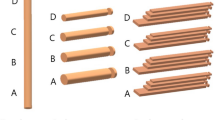Abstract
The aim of this study was to compare the volume yields and contribution margins in the production of clear finger-jointed boards using lower quality raw materials from four suppliers. The study is based on production statistics from 2005 to 2007 and has been carried out in cooperation with a company which manufactures clear finger-jointed boards for mouldings. The raw material was side-boards of Scots pine (Pinus sylvestris L.) with dimensions of 32 by 175 mm2. The four raw material suppliers are geographically distributed in different places in Central Sweden. Parallel with the study, a tool for production follow-up has been developed, to make it possible for the company to continuously follow-up its raw material suppliers.
The results of the study show that the cheapest raw material gives the highest clear wood volume yield and the highest contribution margin.
Zusammenfassung
Ziel dieser Studie war es, die Volumenausbeuten und die Bruttogewinne bei der Herstellung astfreier keilgezinkter Bretter aus Brettern geringerer Qualität von vier Lieferanten zu vergleichen. Die Studie wurde auf Grundlage von Produktionsstatistiken der Jahre 2005 bis 2007 in Zusammenarbeit mit einer Firma durchgeführt, die astfreie keilgezinkte Bretter für Schreinerarbeiten herstellt. Als Rohstoff dienten Seitenbretter aus Kiefernholz (Pinus sylvestris L.) mit den Abmessungen 32 × 175 mm2. Die vier Rohstofflieferanten stammten aus unterschiedlichen Gegenden in Zentralschweden. Parallel zu dieser Untersuchung wurde ein Programm zur Produktionsverfolgung entwickelt, das der Firma eine kontinuierliche Rückverfolgung der Herkunft der verwendeten Bretter ermöglicht.
Die Untersuchung ergab, dass das billigste Ausgangsmaterial die höchste Volumenausbeute und den höchsten Bruttogewinn ergab.
Similar content being viewed by others
References
Anon (1982) Guiding principles for grading of Swedish sawn timber for export. Föreningen Svenska Sågverksmän. Arbor Publishing AB, Stockholm
Anon (1994) Grading rules for pine and spruce sawn timber. Föreningen Svenska Sågverksmän. Arbor Publishing AB, Stockholm
Anon (2000) Sawn timber – Appearance grading of softwoods – Part 1: European spruces, firs, pines and Douglas firs. SS-EN 1611-1. SIS, Swedish Standards Institute, Stockholm
Åstrand E (1996) Automatic Inspection of sawn Wood. Department of Electrical Engineering, Linköpings universitet, Linköping
Bowyer JL, Kallio E, Monson CR, Nicholls D (1986) Standard blanks: a new alternative to hardwood lumber. For Prod J 36(2):67–73
Maness T, Wong D (2002) A Benchmarking System for Evaluating the Profitability and Yield of Optimizing Chop Saw Systems. For Prod J 52(10):52–61
Nylinder M, Törnmarck J (1985) Sågtimrets kvalitet förr och nu. I Kvalitet – behöver vid det? Skogshögskolans höstkonferens 4–5 december 1984, Uppsala. Skogsfakta Konferens Nr 6 1985 (In Swedish)
Pellicane PJ, Stanfill-McMillan K, Tichy RJ (1987) Effects of knots near the fingers of fingerjointed dimension lumber. For Prod J 37(5):13–16
Sandberg D, Holmberg H (1996) Radially sawn timber. Knots – number, type and size in star-sawn triangular profiles of pine (Pinus silvestris L.) and spruce (Picea abies Karst). Holz Roh- Werkst 54(5):369–376
Sandberg D, Johansson J (2006) Simulation of the yield of knot-free components from Scots pine (Pinus sylvestris L.) – A comparative study of star sawing and square sawing. Mater Sci Eng 1(3/4):108–115
Zuo X, Buehlmann U, Thomas RE (2003) Lumber Cost Minimization through Optimum Grade-Mix Selection. In: Deisenroth MP (ed) Enterprise integration, a production perspective, electronic proceedings of the 17th international conference on production research; 2003 August 3–7; Blacksburg, VA. Virginia Polytechnic Institute, Blacksburg, VA
Author information
Authors and Affiliations
Corresponding author
Rights and permissions
About this article
Cite this article
Eliasson, L., Kifetew, G. Volume yield and profit in the production of clear finger-jointed Scots pine (Pinus sylvestris L.) boards . Eur. J. Wood Prod. 68, 189–195 (2010). https://doi.org/10.1007/s00107-009-0367-4
Received:
Published:
Issue Date:
DOI: https://doi.org/10.1007/s00107-009-0367-4




